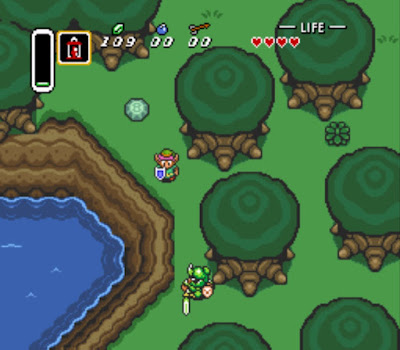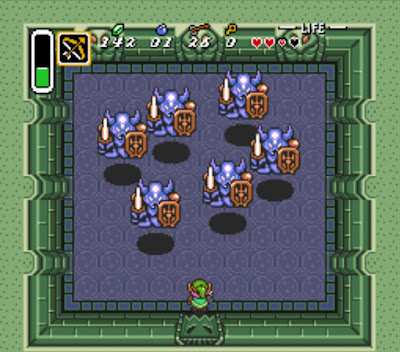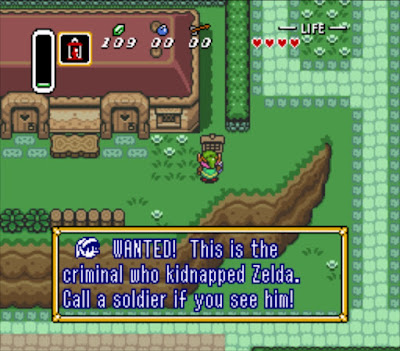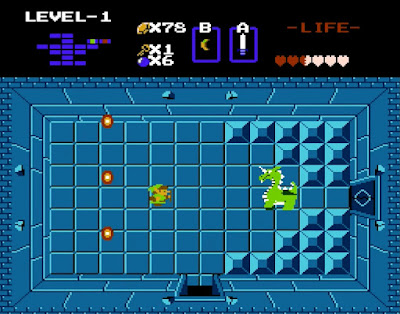 |
| An evil wizard seizes control of Hyrule, using sinister rituals to free Ganon from the Dark World! |
Original Release: Nov. 21, 1991, Super Nintendo. Version Reviewed: NES Classics, 1991. Platform Used: Nintendo 3DS.
THE PLOT:
It is a dark time for Hyrule. The evil wizard Agahnim has seized power and has captured the descendents of the Seven Sages who imprisoned Ganon, Prince of Darkness, long ago. One by one, Agahnim subjects his hostages to a dark ritual from which none return... and soon, it will be Princess Zelda's turn!
A desperate Zelda sends a psychic cry for help to young Link. Following her instructions, he sneaks into the palace and, armed only with the most basic sword and shield, fights his way down to the dungeon to free her.
He takes Zelda to a Sanctuary, believing his part is done. Instead, the priest informs him that his adventure is only beginning. Agahnim has been using his magic to send the descendants of the Sages to the Dark World. There, they become Ganon's prisoners - and the key to his freedom.
Link will need the help of the elder, Sahasrahla, to find the Master Sword and defeat Agahnim. Even then, he's far from done: He must travel to the Dark World to free Ganon's prisoners and to face the Prince of Darkness himself!
 |
| Exploring the overworld while fighting (or avoiding) enemies. |
GAMEPLAY:
The Legend of Zelda series, at least up to this point, is all about the gameplay. The original Legend of Zelda had challenging but fun gameplay, and it stands up as a terrific game. Zelda II's gameplay was intensely frustrating, and it quickly became unenjoyable.
A Link to the Past seems far more modeled after the original game in terms of atmosphere and gameplay style. As in the first game, you play from a top-down perspective, both in the overworld and in dungeons. There's an element of exploration in the overworld, with many hidden items and power-ups to be discovered by finding the right secret paths or by solving the right puzzles. Dungeons are focused on finding keys to allow you to move forward while defeating enemies and avoiding obstacles.
This game moved the series from the Nintendo Entertainment System to the far more powerful Super Nintendo, and the developers had some fun with the gameplay mechanics. You gather a fairly extensive range of equipment and spells as you play, and these open up new strategies and even new areas. The "hook shot," for example, is basically a grappling gun, allowing Link access to areas that would otherwise be unreachable. Other items allow you to pick up heavy objects that otherwise block paths, to get through obstacles without taking damage, and even to create platforms in thin air.
The cleverest ability is the game's most famous: hopping between "The Light World" and "the Dark World." There are several points throughout the game in which shifting between worlds will open up a new passage or lead to a new bit of treasure. The late game palaces can't even be reached without a few dimension hops! As a result, the concept of the twin worlds becomes not just a plot point, but a cornerstone of the game.
 |
| Link faces a group of heavily armored knights in one of the game's first boss battles. |
DIFFICULTY:
A Link to the Past is a challenging game, but it's noticeably easier than the two NES titles. Enemies are rarely overwhelming, and almost all of them can be defeated just with Link's sword, close attention to movement patterns, and a bit of patience. Spells can also clear all the enemies in a room ("Bombos" is very useful for this) - although doing so will use up Magic Points, which I personally prefer to save for boss fights.
One thing this game does have in common with Zelda II is that the boss fights at the end of each of the palaces end up being the most enjoyable combat encounters, with different bosses requiring different tactics. Your first boss is a guard with a mace; dodge the mace, run in for a couple quick hits, and run out before he swings it again. The second boss is a group of armored knights. If you've been paying attention to Sahasrahla's instructions, you'll have already gathered the item to most effectively deal with them.
The only actual hard boss, in my opinion, is Ganon himself. The fight is never unfair, and attentive gamers should figure out the correct strategies for dealing with both stages of the fight (and the game gives you a chance to scout around for "hearts" to heal with in between stages). Still, it's a good idea to go in with multiple health potions, as Ganon can knock your health down pretty darn fast!
 |
| Link is made the scapegoat for the evil wizard's crimes. |
THOUGHTS:
A Link to the Past is often regarded as one of the best of the Legend of Zelda series. Since I'm only three games in, I can't yet comment on that. It is certainly a very good game, though, and it represents a big step forward in complexity, not just in gameplay and graphics, but also in storytelling.
The stories for the two NES games were more or less reserved for their instruction manuals. Anyone buying these games digitally is left to go online to search for .pdfs of the manuals if they want to understand exactly what Link is doing and why.
By contrast, A Link to the Past offers a complete, three Act narrative. A prologue on the menu screen gives you backstory before you even start the game. Once you do begin, you get a scene in which Zelda's cry for help reaches Link before you actually begin playing. There's also a fair amount of dialogue as Link interacts with other characters. Some will give gameplay tips, others exposition, and still others will offer up tiny side quests and mini-games.
My Final Fantasy reviews have already convinced me that I just plain like the look of Super Nintendo games. There's enough detail for environments to feel distinct. The settings are bright and colorful in a way that's genuinely charming. Oh, and Koji Kondo's soundtrack is excellent, with different themes for different settings, for overworld exploration, for dungeon crawling, and for boss battles. The music and the way it's used gives a tremendous boost to the overall atmosphere.
I do have a few quibbles. The story is quite strong for the first half, with Link's rescue of Zelda leading to an evolving quest, with a new goal ready to meet his every accomplishment. This continues right up until Link gains the ability to travel back and forth between Hyrule and The Dark World. At this point, the gameplay grows more complex... but the story flattens out.
Once Link is in the Dark World, the rest of the game could be summarized as: "Go to palace, defeat boss, rescue prisoner and collect TriForce piece. Repeat until final boss fight." The second half is actually the stronger in gameplay terms... but as someone who responds more to plot and characterization, I couldn't help but be disappointed by the way the previously well-developed story just sort of "stopped" at this point.
 |
| An NPC has a mini game for Link. There are a few of these, and even a couple of side quests. |
OVERALL:
A Link to the Past brought the Zelda series into the Super Nintendo era with more detailed graphics, more complex gameplay, and an actual story that exists in the game and not just the instruction manual.
I would have liked a bit more story in the second half, as the narrative seems to run out just when the gameplay becomes really interesting. Still, across all three Zelda games I've played so far, it's clear that gameplay is the primary focus - and A Link to the Past's gameplay is flat-out excellent, varied and clever and consistently staying on just the right side of the line separating "challenging" from merely frustrating.
A very good game, and a major step forward for the series.
Overall Rating: 8/10.
Previous Game: Zelda II - The Adventure of Link
Next Game: Link's Awakening (not yet reviewed)
Review Index
To receive new review updates, follow me:
On Twitter:
On Threads:








